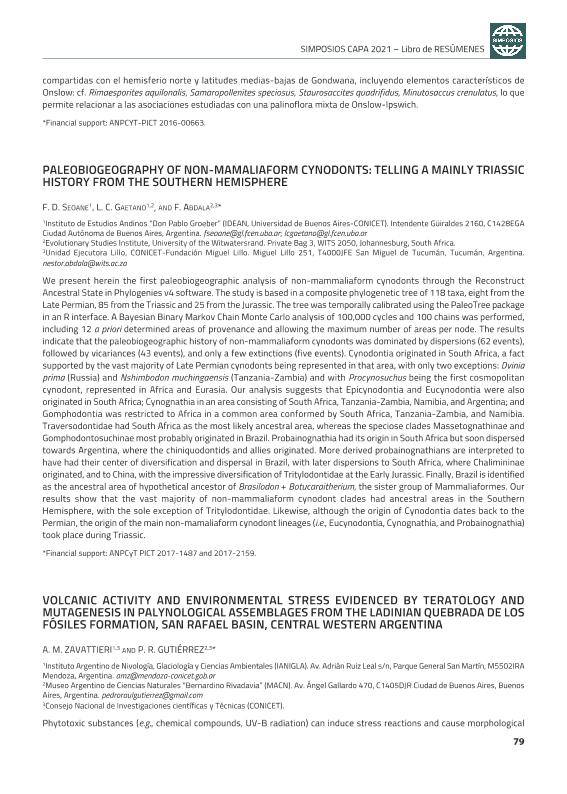Mostrar el registro sencillo del ítem
dc.contributor.author
Seoane, Federico Damián

dc.contributor.author
Gaetano, Leandro Carlos

dc.contributor.author
Abdala, Fernando
dc.date.available
2022-11-25T16:07:55Z
dc.date.issued
2021
dc.identifier.citation
Paleobiogeography of non-mamaliaform cynodonts: telling a mainly Triassic history from the southern hemisphere; XII Congreso de la Asociación Paleontológica Argentina; Argentina; 2021; 1-1
dc.identifier.issn
2469-0228
dc.identifier.uri
http://hdl.handle.net/11336/179032
dc.description.abstract
We present herein the first paleobiogeographic analysis of non-mammaliaform cynodonts through the Reconstruct Ancestral State in Phylogenies (RASP) v4 software. The study is based in a composite phylogenetic tree of 118 taxa, eight from the Late Permian, 85 from the Triassic and 25 from the Jurassic. The tree was temporally calibrated using the PaleoTree package in an R interface. A Bayesian Binary Markov Chain Monte Carlo (BBM) analysis of 100,000 cycles and 100 chains was performed, including 12 a priori determined areas of provenance and allowing the maximum number of areas per node. The results indicate that the paleobiogeographic history of non-mammaliaform cynodonts was dominated by dispersions (62 events), followed by vicariances (43 events), and only a few extinctions (5 events). Cynodontia originated in South Africa, a fact supported by the vast majority of Late Permian cynodonts being represented in that area, with only two exceptions: Dvinia prima (Russia) and Nshimbodon muchingaensis (Tanzania-Zambia) and with Procynosuchus being the first cosmopolitan cynodont, represented in Africa and Eurasia. Our analysis suggests that Epicynodontia and Eucynodontia were also originated in South Africa; Cynognathia in an area consisting of South Africa, Tanzania-Zambia, Namibia, and Argentina; and Gomphodontia was restricted to the Africa in a common area conformed by South Africa, Tanzania-Zambia, and Namibia. Traversodontidae had South Africa as the most likely ancestral area, whereas the speciose clades Massetognathinae and Gomphodontosuchinae most probably originated in Brazil. Probainognathia had its origin in South Africa but soon dispersed towards Argentina, where the chiniquodontids and allies originated. More derived probainognathians are interpreted to have had their center of diversification and dispersal in Brazil, with later dispersions to South Africa, where Chalimininae originated, and to China, with the impressive diversification of Tritylodontidae at the Early Jurassic. Finally, Brazil is identified as the ancestral area of hypothetical ancestor of Brasilodon + Botucaraitherium, the sister group of Mammaliaformes. Our results show that the vast majority of non-mammaliaform cynodont clades had ancestral areas in the Southern Hemisphere, with the sole exception of Tritylodontidae. Likewise, although the origin of Cynodontia dates back to the Permian, the origin of the main non-mamaliaform cynodont lineages (i.e., Eucynodontia, Cynognathia, and Probainognathia) took place during Triassic.
dc.format
application/pdf
dc.language.iso
eng
dc.publisher
Asociación Paleontológica Argentina

dc.rights
info:eu-repo/semantics/openAccess
dc.rights.uri
https://creativecommons.org/licenses/by-nc-sa/2.5/ar/
dc.subject
Paleobiogeography
dc.subject
Cynodontia
dc.subject
Triassic
dc.subject
Quantitative analysis
dc.subject.classification
Paleontología

dc.subject.classification
Ciencias de la Tierra y relacionadas con el Medio Ambiente

dc.subject.classification
CIENCIAS NATURALES Y EXACTAS

dc.title
Paleobiogeography of non-mamaliaform cynodonts: telling a mainly Triassic history from the southern hemisphere
dc.type
info:eu-repo/semantics/publishedVersion
dc.type
info:eu-repo/semantics/conferenceObject
dc.type
info:ar-repo/semantics/documento de conferencia
dc.date.updated
2022-09-27T10:46:26Z
dc.journal.pagination
1-1
dc.journal.pais
Argentina

dc.journal.ciudad
CABA
dc.description.fil
Fil: Seoane, Federico Damián. Consejo Nacional de Investigaciones Científicas y Técnicas. Oficina de Coordinación Administrativa Ciudad Universitaria. Instituto de Estudios Andinos "Don Pablo Groeber". Universidad de Buenos Aires. Facultad de Ciencias Exactas y Naturales. Instituto de Estudios Andinos "Don Pablo Groeber"; Argentina
dc.description.fil
Fil: Gaetano, Leandro Carlos. Consejo Nacional de Investigaciones Científicas y Técnicas. Oficina de Coordinación Administrativa Ciudad Universitaria. Instituto de Estudios Andinos "Don Pablo Groeber". Universidad de Buenos Aires. Facultad de Ciencias Exactas y Naturales. Instituto de Estudios Andinos "Don Pablo Groeber"; Argentina
dc.description.fil
Fil: Abdala, Fernando. Consejo Nacional de Investigaciones Científicas y Técnicas. Centro Científico Tecnológico - Tucumán. Unidad Ejecutora Lillo; Argentina
dc.relation.alternativeid
info:eu-repo/semantics/altIdentifier/url/https://www.apaleontologica.org.ar/wp-content/uploads/2022/02/XII-CAPA-Libro-de-Resu%CC%81menes-2021.pdf
dc.conicet.rol
Autor

dc.conicet.rol
Autor

dc.conicet.rol
Autor

dc.coverage
Internacional
dc.type.subtype
Congreso
dc.description.nombreEvento
XII Congreso de la Asociación Paleontológica Argentina
dc.date.evento
2021-11-23
dc.description.paisEvento
Argentina

dc.type.publicacion
Journal
dc.description.institucionOrganizadora
Asociación Paleontológica Argentina
dc.source.revista
Publicación Electrónica de la Asociación Paleontológica Argentina
dc.date.eventoHasta
2021-11-26
dc.type
Congreso
Archivos asociados
